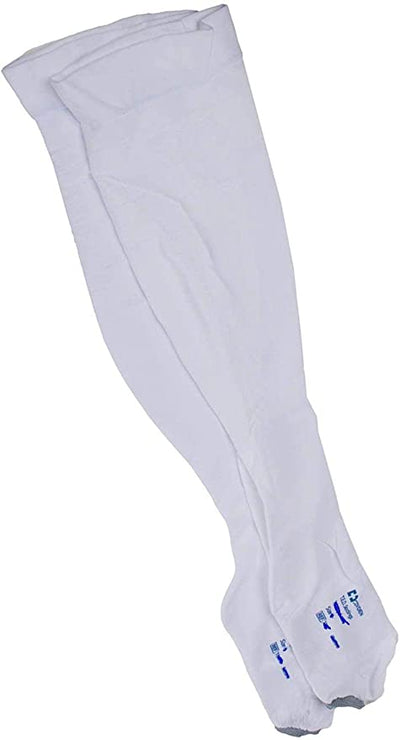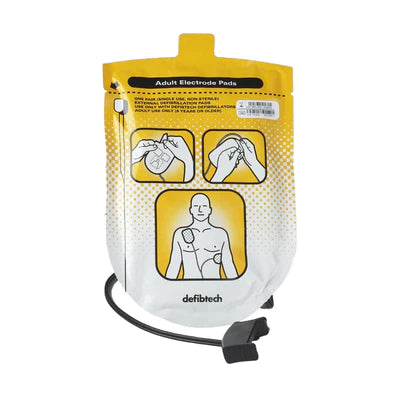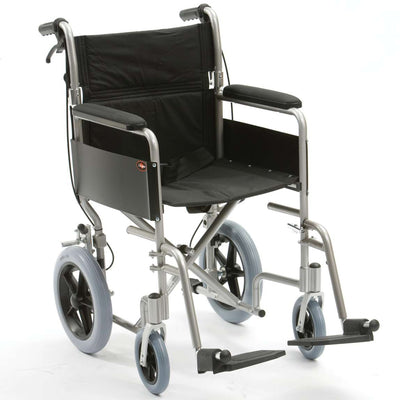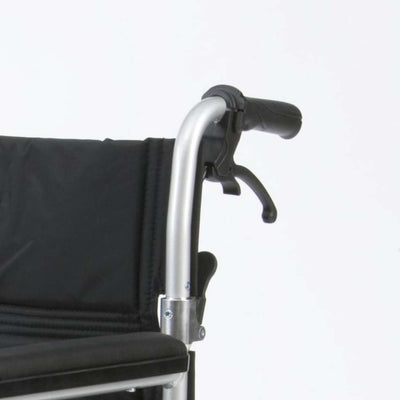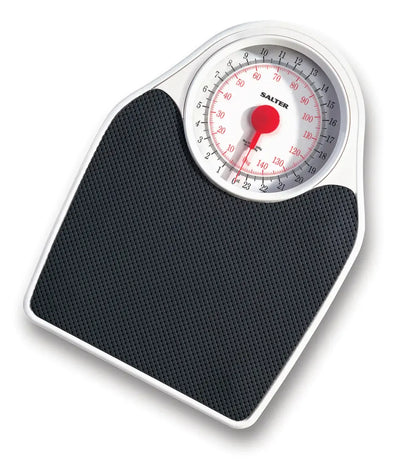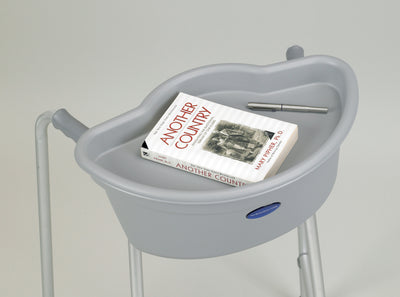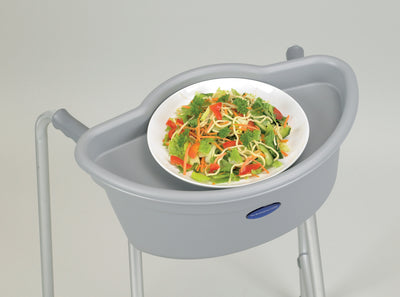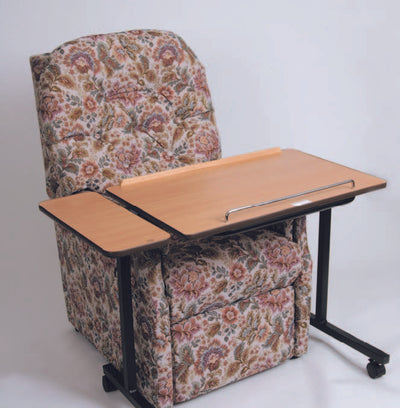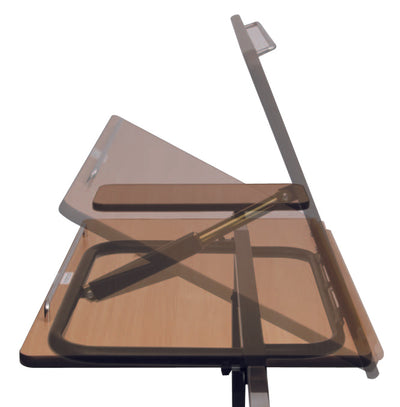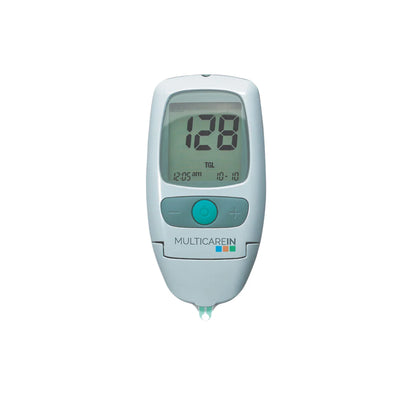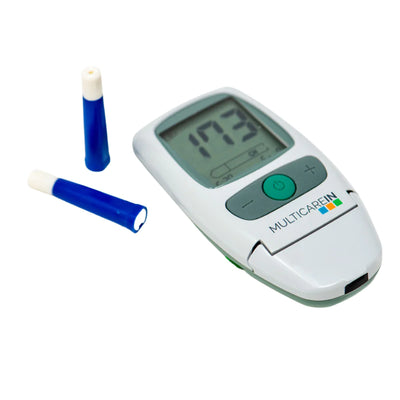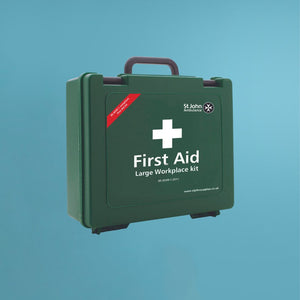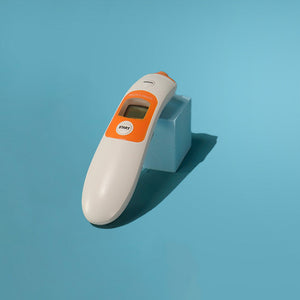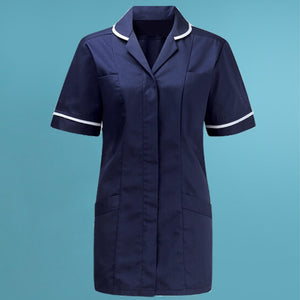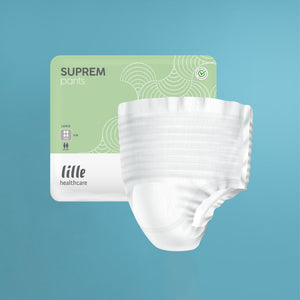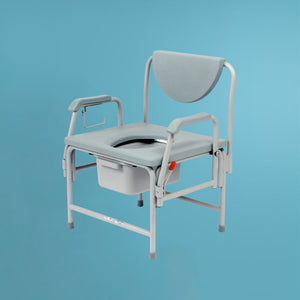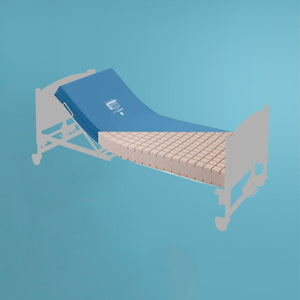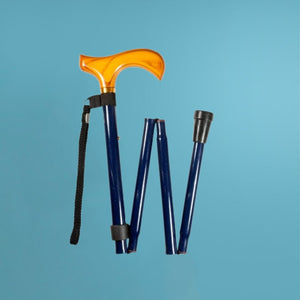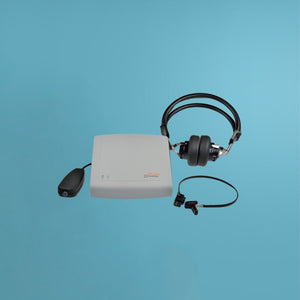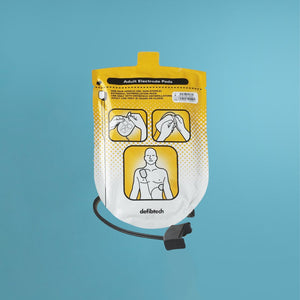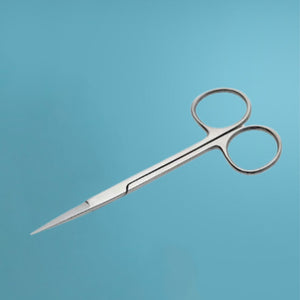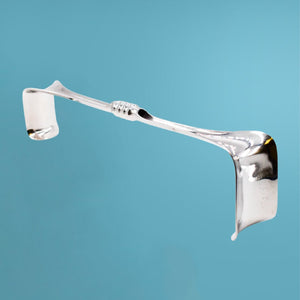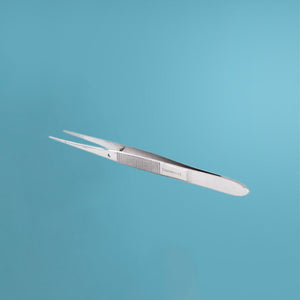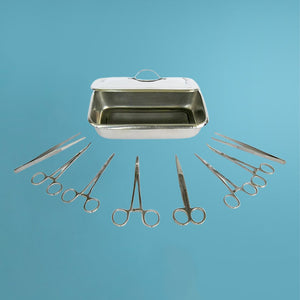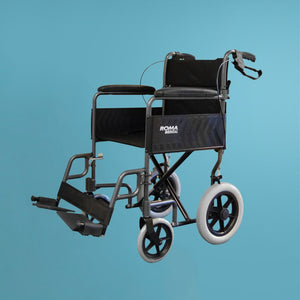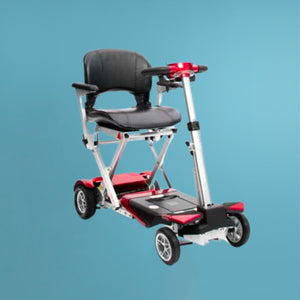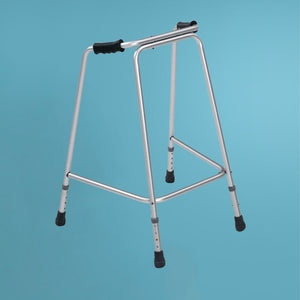Blogs
Explore a world of wellness on our health blog – your daily dose of inspiration, tips, and insights for a healthier, happier life.
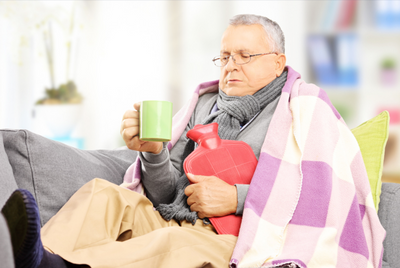
Does Cold Weather Affect your Heart?
19.09.2023
Much of the UK has been experiencing a cold snap with temperatures plummeting since the New Year, and snow and black ice covering much of the country. While it makes for a picture postcard view, the cold weather can make life considerably more difficult, if even life threatening, for the elderly, vulnerable and those who suffer with heart conditions.
This week’s blog is inspired by the great work done at the British Heart Foundation and you can read more about how the cold can affect you if you suffer from a heart condition on their website here.
Does cold weather put me at risk if I have a heart condition?
In short, cold weather can bring health and heart risks to many of us - however, the elderly and very young children do find it harder to regulate their body temperature, which puts them at a higher risk.
During the winter, when temperatures drop, our bodies have to work much harder to keep warm.That means our hearts need to jump into action to work extra hard at pumping blood around our systems to keep everything ticking over. Everything from brain function to moving, digesting food and breathing is dependent on a good, healthy blood flow through the heart.
When the body experiences cold temperatures, the blood vessels and arteries narrow, restricting blood flow and reducing oxygen to the heart. A harder working heart can then result in higher blood pressure, blood clots, heart attack or stroke.
What can I do to protect my heart?
Thankfully, no matter our age or condition, there are many ways we can stay warm and help to look after our hearts during the colder months.
There are many things you can do to stay warm and look after your heart in cold weather.
Stay Active - most of us will be spending a lot more time in our homes just now due to COVID-19 restrictions, but that’s no reason to not keep our bodies moving. If you can, make sure you take some time to get outdoors for a short walk. If you are housebound, but still mobile, make sure you regularly get up for a walk around the house. Regular movement is key to keeping the heart pumping healthily.
Wrap up warm - wear plenty of layers of clothing made from natural fibres if possible - including your socks! Three layers of thin clothing will be much better for you than one thick, ‘warm’ jumper for example as the air trapped between the layers will warm up to create a cosier feeling. And don’t forget that wearing a good pair of slippers around the house can also be a great defence against your body cooling down.
Eat regularly - have plenty of hot drinks throughout the day to give your body enough energy to keep you warm. Healthy soup, stews, casseroles and warm flavoured teas are all good choices. If you’re a slow eater and struggle to complete a meal before the food goes cold, you might find one of these keep warm dishes useful in the winter months.
Keep your house warm - if you can, pop the heating on for periods throughout the day, but especially in the early morning and evenings when temperatures are lowest. Or, use a hot water bottle or an electric blanket to keep you warm without spending money heating rooms you’re not using.
If you’d like to find if you’re eligible for support with your energy bills through the Government’s Winter Fuel Payment Scheme you can contact them here Winter Fuel Payment Centre on 03459 15 15 15.
Don’t forget that if you are concerned about any health conditions related to your heart, contact your GP immediately. You will also find very useful advise at the British Heart Foundation.
Need more support? We're always here to help.
For all your Medical and Homecare supplies give us a call at Mediworld.
We have over 40 years experience in medical, surgical and home health supplies and we're always on hand to chat if you need support or advice. Follow us on Twitter and Facebook.
Learn More Now
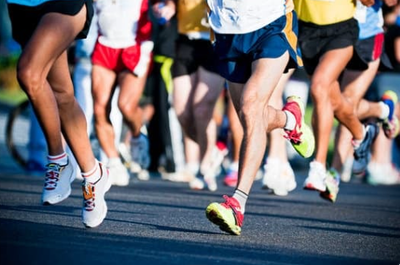
Recovering from Running Your First Marathon
26.09.2023
You’ve done the training. Tapering and carb loading are in the bag. You’re mentally and physically prepared to toe the line and enjoy (endure?!) all of the 26.2 miles ahead of you.
But have you thought about how your body will feel once you’re done?
With your mind and body focused on getting to the finish line, have you taken a minute to plan your recovery in the hours and days after the race?
Planning for a good marathon recovery is just as important as following a pre-race training plan to get you through the miles. So while you’re in your tapering week, take the extra time you have on your hands to think through how you’ll treat your body for optimum repair in the hours, days and weeks after you cross that finish line!
How will you Feel?
Running 26.2 miles will leave you with more than just a few sore muscles - although these might seem like your most pressing concern.
Your immune system will be suppressed and you’ll be more susceptible to colds and sickness.
Your muscle strength will be reduced as your body protects itself while repairing the network of damaged tissue and muscles.
Your heart might be slightly weakened or even damaged (although this can be avoided if your training has been sensible, consistent and plentiful)
Your coordination and muscle memory will be compromised making you more susceptible to stress injuries in the following 2-3 weeks.
Recover Sensibly
You will want to take your recovery in stages as your body will be going through some major repair work over the hours, days and weeks to come.
Immediately after the race:
Keep moving.
You might want to stand still, lie or sit down but this can actually cause you to faint, so make sure you keep moving for 15-20 minutes after you stop running to clear your muscles and blood stream of adrenaline, cortisol and lactic acid. Your muscles will thank you for this in the next few days.
Rehydrate.
After 26.2 miles your body will be dehydrated. Be sure to drink and if you can include some electrolytes in the water to replace lost salt and minerals, even better.
Eat.
You might be starving or you might feel queasy with a loss of appetite. Either way, try to eat some good protein within 15-30 minutes after you finish running. Protein will help to kickstart muscle recovery and repair. You should eat a more substantial meal filled with carbohydrates and protein as soon as you feel ready to stomach it (and yes, this is your chance to treat yourself to that burger and chips!). You can focus on healthy foods from the meal after that if you want!
Rest.
Once you’re home and showered, you should take a nap. Prioritizing sleep should be number one on your recovery list this week. You might struggle to sleep well on the first night, so don’t worry. Take regular naps and get to bed early this week.
Ice.
To combat swollen joints and muscles, and if you’re brave enough, you could consider taking an ice bath - empty a bag of ice in a tub of cold water and immerse your lower body for 10-15 minutes. Not ready to take that plunge? Ease and cool aching joints with a koolpak throughout the coming hours and days.
Compression.
Compression is a proven method of recovery from marathon running. In fact, runners who wear compression socks or compression tights for 48 hours after a marathon have been shown to have greater muscle and mobility recovery within the first 2 weeks over those who don’t. These don’t need to be sport specific and any available compression sock/tight will be sufficient.
For extra compression therapy which promotes lymphatic drainage and circulatory flow, some athletes will use an air compression massage bag. While much more expensive than a regular compression sock it’s an impressive piece of equipment for home therapy and can treat DVT, sciatica, sprains, injuries and much more.
Elevation.
Raise your legs with a foam leg raiser to support your swollen legs and stimulate circulation.
The Week after the Race.
In the first few days after running a marathon you’ll want to find some gentle ways to keep moving to promote lots of lovely blood flow and muscle repair.
Don’t be tempted to run - that’s not sensible. Even the elite runners take time off after a major event.
Walk, swim or maybe cycle but keep your movement low-intensity. The goal is to promote blood flow and keep your joints moving, not to build fitness or strength.
You will want to eat lots of anti-inflammatory foods to reduce the inevitable swelling that will occur around those damaged and overworked muscles and joints. Inflammation is a natural and useful stage in muscle repair so you don’t want to remove it all together. Anti-inflammatory foods will be more useful to your recovery than anti-inflammatory medicines.
Massage.
Leave it at least 2 days before considering having a massage, to allow for some reduction in inflammation first. Make sure you tell your massage therapist that you’ve just run a marathon and they will be able to keep the pressure light to gently work your tired muscles and promote extra circulation for a good recovery.
A great option for post-run recovery is to use an at-home massage gun. It’s an easy way to give yourself a deep-tissue massage at home for a fraction of the price of regular sports massage and it will help with both injury prevention and post-run muscle rehabilitation.
You Did It
Most importantly, listen to your body as you slowly become more mobile, flexible, strong and maybe even ready to try a gentle run after your first week of recovery.
Take your recovery seriously and your body will thank you for it. You might just get back on track and manage to hit some PB goals in your next marathon!
Need more help? We're always here to help so get in touch today.
For all your Medical and Homecare supplies give us a call at Mediworld.
We have over 40 years experience in medical, surgical, mobility and home health supplies and we're always on hand to chat if you need support or advice and don't forget to read our other great health blogs!
April 2023
Learn More Now
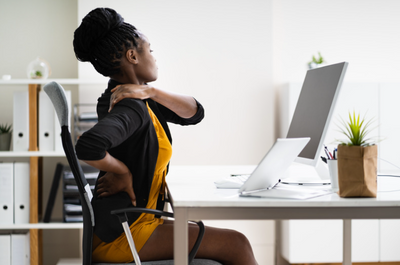
Tips for Keeping Fit if you Sit Down at Work all Day
20.09.2023
We all know that, unless you are a wheelchair user, sitting all day is really bad for us. The human body wasn’t designed to be as inactive as our modern lifestyle dictates, and those of us who sit at a desk or behind the wheel for 8 hours a day are more vulnerable to the aches, pains and long-term diseases that come with a sedentary lifestyle. Sitting all day isn’t doing us any good.
Thankfully, if you do have to sit all day for work (or even if you like to spend your evenings on the sofa watching tv), there are some good habits that you can start to introduce to make you generally healthier and more productive in your day.
What does sitting for long periods of time do to us?
Sitting all day is at best, linked to skeletal and muscular issues like back and shoulder pain, and at worst a direct route into chronic health diseases like cancer, stokes, heart conditions and diabetes.
Sitting for long periods is thought to slow the metabolism, which affects the body’s ability to regulate blood sugar, blood pressure and break down body fat. Sitting isn’t weight bearing, so can lead to weaker bones and muscles which in turn can encourage the development of osteoporosis and broken bones in older age.
Current research doesn’t suggest how long is too long when it comes to sitting - so we don’t yet know if there is an ‘acceptable’ amount of hours of sitting each day. What we do know is that more movement and less sitting is the mantra we should all use in our everyday life.
Moving habits for every day
We have to be realistic about lifestyle changing, as for many of us it’s impossible to suddenly swap our desk jobs for one that allows us to walk around being active all day. The good news is, the research says that there are some really easy habits you can adopt to improve your health - some of which you can do while sitting at your desk!
Have a go at incorporating some of these simple habits into your day and you’ll soon start to see and feel the health benefits.
** Get up every 30 minutes if you can for just a light, 5 minute walk. This has been shown to significantly reduce blood sugar levels, reducing the blood sugar spike after eating by almost 60 per cent compared to sitting down.
** Take the stairs - avoid the lift or escalators, and walk when you can (taking a phone call, chatting to a colleague, on the bus etc). You’ll get your step count up and enjoy the benefits of the cardio and weigh bearing exercise this brings.
** Use an under desk pedal exerciser. Believe it or not, pedalling at gentle pace can burn approximately 100 calories each day on average. So that’s 500 calories per day for five days a week. You’ll also increase the blood and oxygen flow around your body while you’re replying to emails etc, which will hugely improve your concentration and productivity.
We’re huge fans of using a pedal exerciser for people who have to sit for long periods. Once you get into the habit of using the pedals while sitting, you’ll be amazed how it becomes second nature and you’ll soon see and feel the incredible health benefits that come with it.
** Keep active while watching TV. You don’t need to slump on the sofa to enjoy your favourite shows. Why not do some standing stretches or some strength exercises with exercise bands during the ad breaks or while you’re waiting for the kettle to boil.
There’s always an opportunity to choose standing over sitting and to engage your muscles while you’re going about your day to day activities.
Need more help? We're always here to help so get in touch today.
For all your Medical and Homecare supplies give us a call at Mediworld.
We have over 40 years experience in medical, surgical, mobility and home health supplies and we're always on hand to chat if you need support or advice and don't forget to read our other great health blogs!
January 2023
Learn More Now
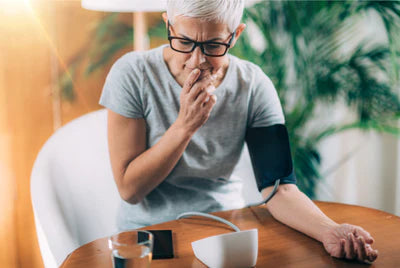
5 At-Home Health Checks to do this Winter
07.02.2024
Keeping on top of your health goes beyond seeing your GP when you feel unwell. In fact, many serious health problems are first picked up at home, and not in the GP surgery. Since no-one knows your body better than you do, it makes sense for you to routinely do your own at-home health checks to keep on top of any changes in your health and wellbeing.
Here are 5 easy, but important, health checks you can start doing at home today.
Blood Pressure
High or low blood pressure can lead to a variety of often life-threatening health conditions, so keeping a regular check of your own blood pressure can help to prevent issues like dizziness, heart attacks or strokes.
Using a Blood Pressure Monitor at home is quick and easy. Check your blood pressure in the morning and evening to gauge your normal resting rate. The NHS Blood Pressure Checker has a useful tool for checking and understanding your blood pressure monitor readings.
If you’re a relatively healthy adult you should only need to check your blood pressure once a month. If you have any underlying conditions you may need to check more often and you should discuss the frequency with your GP.
In the UK if you’re over 40 you should have your blood pressure measured as part of your NHS Health Check, but regularly measuring your levels at home can help with early detection. Thankfully your GP will have measures that you can take to lower your blood pressure and prevent serious complications.
Pulse Rate
A major cause of death for both men and women is heart disease. Checking your resting heart rate, or pulse rate, regularly is a simple self-examination you can do at home to assess the health of your heart and general wellbeing.
While sitting or lying down, place the first two fingers of one hand on the base of the wrist of the other hand until you feel a pulse. Count the pulse beats for either 60 seconds, or for just 30 seconds then multiply by 2. Make sure you test when you have been sitting or at rest for some time - it’s a good idea to do this when you wake up, for example. You can also find your pulse on the side of your neck between your jaw and your windpipe. Make sure you don’t use your thumb to take your pulse.
In a healthy person, the resting heart rate, or pulse rate, should be between 60 and 100 beats per minute, although if you’re very fit it could be lower than this. If you test multiple times outside of that range, it could mean you have a cardiovascular issue. If you feel an irregular beat this could also indicate an issue and it’s best to discuss this with your GP.
Breast Check
Early detection of breast cancer offers the best chance of successful treatment of the disease. Regularly examining your breasts for changes, discolourations and lumps can help you detect issues early.
You should get used to how your breasts look and feel, as any changes will be easier to detect. Regularly, look at your breasts in the mirror - first with your arms down, then with them raised in the air. Look for signs of discolouration, puckering, spotting or lumps.
Get used to how your breasts feel by regularly feeling for any lumps or bumps. Use a circular motion to check the full breast area, as well as under the armpit and around the nipple.
If you spot any changes or anything that worries you, arrange to see you GP or nurse for a chat and further investigation. Not all changes will be cancerous but they should all be checked out.
Don’t forget that breast cancer can also affect a small percentage of men, so these checks are recommended for both men and women.
Oxygen Levels
Since the onset of the Covid-19 pandemic there has been a much greater awareness of the importance of checking your blood oxygen levels, especially if you’re suffering from a respiratory infection. At-home oximeters have become staple items in home first aid kits.
Oxygen in your blood helps replace worn out cells, provides energy for your body, supports your immune system functions and more. A low blood oxygen level may be a sign of poor circulation and lung issues. A normal blood oxygen level is 95% or higher. Monitoring your own blood oxygen level at home is easy and fairly inexpensive with a finger blood oxygen monitor or oximeter and it’s a great way to make you aware when it may be time to see the GP or, at worse, ring for emergency support.
Mole Check
The first sign of melanoma or skin cancer is often in a new mole or a change in an existing mole on the skin. So get to know your moles, and check them regularly — once a month, ideally, especially if you’re fair-skinned, have a family history of skin cancer, or have a lot of moles.
Look out for any mole that is getting bigger, changing shape or colour, bleeding, itching or becoming crusty.
Use the “ABCDE” warning signs: A, for asymmetrical - melanoma often have 2 very different halves; B for irregular borders; C for abnormal colour; D for diameter - most are bigger than 6mm (but not all); E for evolving, meaning the mole changes appearance over time. Melanoma can appear anywhere on your body, but they most commonly appear on the back in men and on the legs in women.
Get anything suspicious checked out by a GP or referred to a dermatologist as soon as possible.
Need more help? We're always here to help so get in touch today.
For all your Medical and Homecare supplies give us a call at Mediworld.
We have over 40 years experience in medical, surgical, mobility and home health supplies and we're always on hand to chat if you need support or advice and don't forget to read our other great health blogs!
January 2023
Learn More Now
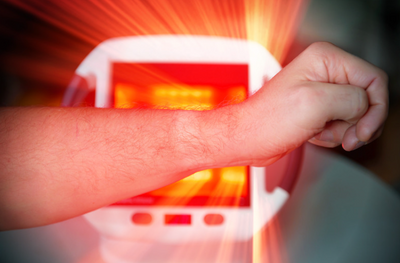
Benefits of using an Infra Red Lamp
24.07.2023
Infrared light therapy, or IRR (Infrared Radiation), is a non-invasive, drug-free alternative treatment offering numerous health benefits. From alleviating pain and reducing muscle tension to improving skin health and supporting weight loss, infrared light therapy is gaining popularity for its diverse range of applications and proven effectiveness.
This comprehensive guide explores the science behind IRR therapy, its various benefits, and how to utilize this healing modality effectively.
What is IRR Therapy?
Infrared light therapy involves using infrared radiation to deliver targeted heat energy into the body. This energy, invisible to the naked eye, falls on the electromagnetic spectrum between visible light and microwave radiation.
IRR therapy exposes the body to infrared wavelengths, penetrating the skin and tissues and promoting various biological processes and therapeutic effects.
There are three types of infrared light – near-infrared, mid-infrared, and far-infrared. Each type displays different properties and depths of penetration, making them suitable for addressing different health concerns. Infrared light therapy devices, such as lamps, saunas, and handheld devices, typically utilize one or a combination of these wavelengths to deliver the desired health benefits.
How Does Infrared Light Therapy Work?
Infrared light therapy works by emitting infrared radiation, which penetrates the body's tissues, muscles, and joints without causing any harm to the skin or other sensitive areas.
Once absorbed, the infrared wavelengths trigger a series of biological processes within the body, including increased circulation, relaxation of the muscles, and stimulation of the body's natural healing mechanisms.
At the cellular level, infrared light can activate mitochondrial responses, increasing the production of adenosine triphosphate (ATP) – the molecule responsible for providing energy to cells. As a result, infrared light therapy can optimize cellular functions, stimulate tissue repair, and promote overall better health.
What are the Benefits of Infrared Light Therapy?
Infrared light therapy offers a wide range of benefits, which can improve various aspects of an individual's physical and mental well-being. Here, we delve into some of the most notable benefits of this alternative healing modality.
1. Enhanced Detoxification
Detoxification is an essential process that helps the body eliminate harmful substances and maintain optimal health. Infrared light therapy can promote detoxification by increasing core body temperature, which leads to increased sweating – a crucial mechanism for removing toxins through the skin.
As a result, infrared light therapy can help cleanse the body and promote overall wellness.
2. Pain Relief
One of the most sought-after benefits of infrared light therapy is its ability to reduce pain. The heat from infrared radiation can penetrate deep into the tissues, muscles, and joints, alleviating inflammation, reducing muscle tension, and promoting relaxation.
Consequently, it can effectively mitigate pain caused by various conditions, such as arthritis, muscle strains, or nerve injury.
3. Reduction of Muscle Tension
Infrared light therapy can help alleviate muscle tension and stiffness by promoting relaxation and enhancing blood flow to the affected areas. The increased circulation enables increased oxygen and nutrient delivery to the muscles, facilitating faster recovery and reducing discomfort.
Hence, infrared light therapy can be a valuable tool for athletes, individuals with chronic pain, or those who experience physical exertion in their daily activities.
4. Relaxation
The deep, penetrating heat offered by infrared light therapy can soothe the body and promote deep relaxation. As the body absorbs the infrared wavelengths, it can experience a gentle warming sensation that helps relieve stress and tension.
In addition, the increased blood flow and muscle relaxation induced by the therapy can help create a calming effect on the nervous system, promoting overall mental well-being.
5. Improved Circulation
Infrared light therapy can stimulate better blood flow by causing blood vessels to dilate, enabling increased oxygen and nutrient delivery to the cells. Enhanced circulation can improve overall health, promote tissue repair, reduce inflammation, and support the body's healing ability.
6. Weight Loss Support
Infrared light therapy can also support weight loss goals by elevating core body temperature, increasing the metabolic rate, and promoting perspiration. The higher energy expenditure induced by the therapy can contribute to burning calories and, when combined with a healthy lifestyle and appropriate exercise, support overall weight management.
7. Skin Purification
Infrared light therapy has been recognized for its positive effects on skin health. The increased circulation and detoxification promoted by the therapy can contribute to healthier-looking skin due to enhanced nutrient delivery and toxin elimination.
Moreover, infrared light can stimulate collagen production, helping minimize the appearance of fine lines and wrinkles and improving overall skin elasticity.
8. Lowered Side Effects of Diabetes
Infrared light therapy can support individuals with diabetes by improving circulation, enhancing wound healing, and reducing inflammation. Enhanced blood flow can help alleviate common diabetic symptoms, such as numbness, tingling, or pain in the extremities.
Moreover, by promoting tissue repair and reducing inflammation, infrared light therapy can benefit diabetic wound care.
9. Boosted Immune System
Infrared light therapy can contribute to a stronger immune system by increasing core body temperature and promoting better circulation. The heat generated by the therapy can simulate a mild fever, activating immune responses and promoting the production of white blood cells, which defend the body against infections and diseases.
10. Lowered Blood Pressure
Infrared light therapy can contribute to lowering blood pressure levels by improving circulation and promoting the relaxation of blood vessels. With consistent use, the therapy can help reduce hypertension, decreasing the risk of developing cardiovascular-related issues.
11. Stress Reduction
Exposure to infrared light can stimulate the production of endorphins. These natural "feel-good" hormones help combat stress and promote well-being. Infrared light therapy and its relaxation benefits can effectively manage stress and promote mental health.
12. Improved Sleep Quality
Infrared light therapy can improve sleep quality by promoting relaxation, reducing pain, and alleviating stress. The deep, penetrating heat from the therapy can help induce relaxation, making it easier for individuals to fall asleep and enjoy uninterrupted, restorative sleep.
13. Accelerated Healing and Recovery
Infrared light therapy can facilitate faster healing and recovery from injuries, surgery, or intense physical exertion by increasing circulation, promoting tissue repair, and reducing inflammation. Consequently, athletes, patients recovering from surgery, or individuals with chronic pain can benefit from infrared light therapy as it supports the body's natural healing processes.
14. Enhanced Lymphatic System Function
The lymphatic system, which plays a crucial role in detoxification and maintaining the body's fluid balance, can benefit from infrared light therapy. Infrared light therapy can contribute to a more efficient and better-functioning lymphatic system by stimulating lymphatic drainage and reducing inflammation.
15. Increased Energy Levels
Lastly, infrared light therapy can increase overall energy levels by promoting better circulation, supporting the production of ATP, and reducing the body's fatigue-causing toxins. As a result, regular use of infrared light therapy can leave individuals feeling more energetic and revitalized.
How to Use Infrared Light Therapy?
Infrared light therapy is available in various forms, such as handheld devices, lamps, saunas, and specialized treatment centers. How to use infrared light therapy will largely depend on the type of device employed and the specific health concern being addressed.
Handheld devices or infrared lamps can be used for targeted treatment, ensuring the infrared light is directed at the affected area for the recommended duration.
Alternatively, infrared saunas or whole-body systems can be used for more comprehensive therapeutic benefits, such as detoxification, stress reduction, and relaxation.
Before starting infrared light therapy, consult a healthcare professional to determine the appropriate treatment wavelength, duration, and intensity for your specific needs and concerns.
How Often Can You Use Infrared Light Therapy?
There is no one-size-fits-all answer to how often infrared light therapy should be used, as it depends on the individual's specific needs, health goals, and device type. However, for most individuals, treatments can range from 2-3 times per week to daily sessions, depending on the desired results and the recommendations of a healthcare professional.
It is essential to follow the device manufacturer's guidelines and the advice of a trained professional to determine the appropriate frequency and duration of treatments for optimal results and safety.
Conclusion
Infrared light therapy is a versatile, non-invasive, pain-free alternative treatment option offering impressive health benefits. By understanding what infrared light therapy is, how it works, and how to use it effectively, individuals can harness the power of this therapeutic modality to enhance their physical and mental well-being.
With its myriad advantages, including pain relief, detoxification, improved circulation, and overall wellness promotion, infrared light therapy is an exceptional addition to any holistic wellness routine.
Learn More Now

How to Stay Positive with Seasonal Affective Disorder
25.09.2023
If you suffer from SAD, winter with its dark days and colder temperatures can be a particularly trying time of year. It can be very hard to stay positive but there are some ways you can boost your mood and increase your ability to cope with the often debilitating symptoms that seasonal affective disorder can bring.
Get Outside
Although the causes of SAD are not entirely known, there is evidence to suggest that lack of sunlight exposure has a large part in causing the symptoms that can occur.
When you get outside in the daylight, you expose yourself to lovely doses of Vitamin D and, consequently, the positive effects of increased serotonin. Without these you can be prone to much lower energy levels, stress, sleeping too much and general feelings of low esteem which can lead to depression.
So try to go outside for a walk every day if you can. A good walk will help to expose your skin (even if it’s just your face) to the sunlight and will go a long way to providing you with an adequate amount of mood boosting Vitamin D. Exercise is another fantastic mood booster so if you can, make sure you get your heart working to pump lots of blood and oxygen around your body - this will work wonders to combat low moods everytime.
If walking is a struggle or you just can’t get out, try wrapping up warm and sitting outside at lunchtime for a warm cuppa. Keep your blinds and curtains open if you’re at home to try to maximise the sunlight coming into your house.
In winter you could also take a daily Vitamin D supplement to boost your levels.
Eat Well
When you’re feeling low it can be very easy to reach for junk foods with little nutritious value. If you drink alcohol, it can also be a time when you might drink too much, leading to a vicious cycle of constantly needing to drink to fight off your increasingly low moods.
However, eating a healthy, balanced diet has been proven to have enormous benefits for your mental wellbeing. And the more you get into the habit of healthy eating the more your body craves the good stuff.
What should be on the menu? Plenty of fruit and veg, as well as bananas, brown rice, oatmeal, oily fish, walnuts and flaxseeds - they’re all filled with omega-3 fats which boost serotonin and keep you feeling positive.
Set a Goal for each Day
This might not immediately appeal to everyone, but having a lack of focus to your day is a fabulous breeding ground for depression, low self esteem and lack of motivation.
Setting yourself a project or a goal - which might be as simple as planning and going for a nice walk, or maybe it’s a task you’d like to complete at home - gives you a reason to get up and to get going each morning. It keeps your mind on track, keeps your day structured and, when you’ve completed your task (or even just had a go at starting it) you’ll feel a sense of accomplishment and positivity.
Don’t forget that you’re allowed to have a fun goal - it doesn’t have to be useful or productive, just achievable.
Sleep Well
Feeling low or depressed can be intertwined with sleeping too much. In turn, sleeping longer can increase a person’s depressed state.
So while it feels perfectly natural to sleep a bit more when the nights are long and the temperature has dropped, you should be mindful of not sleeping too much.
If you’re sleeping more than 10 hours each day, you could be much more prone to low esteem, lethargy, depression and lack of motivation. People with SAD might feel that a daytime nap could improve their state of mind, however, extra sleep is often detrimental to this. It’s far better to try to exercise, or put your mind to your daytime goals, or to reach out and seek some company during the day so that your mind and body are tired in the evening when it is time to settle down to bed.
Practicing good sleeping habits can help you to get the seven to eight hours of quality sleep you need. Go to bed at the same time every night and have the same wake-up time. Avoid caffeine and alcohol too close to bedtime. Regular exercise can improve sleep quality, too. Lastly, make sure your bedroom is comfortable and free of distractions.
And remember
For most people, SAD does lift once the winter is through. So just remind yourself that this will pass, this won’t last forever. Try to have something planned for spring time to look forward to or to work towards so you have something good to reward yourself with after your season of sadness is through.
If you think your low mood is becoming a greater problem and is preventing you from functioning then you should seek help from your GP. Perhaps a general health check will reveal something that can be easily treated and, with treatment, your mood and self-esteem.
Need more help? We're always here to help so get in touch today.
For all your Medical and Homecare supplies give us a call at Mediworld.
We have over 40 years experience in medical, surgical, mobility and home health supplies and we're always on hand to chat if you need support or advice and don't forget to read our other great health blogs!
December 2020
Learn More Now
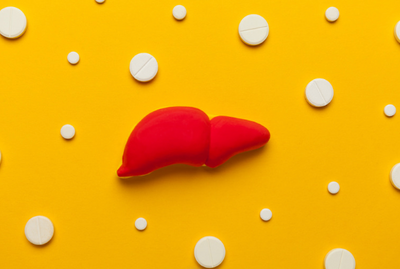
Look after your Liver
26.09.2023
It’s National Liver Awareness Month and a good time to get clued up on how to keep you liver in tip top condition and what signs to look out for that could suggest your liver isn’t functioning as well as it should
What does the liver do?
The liver is an often forgotten organ, but its role in a healthy body’s functioning is huge.
Its main role is to remove toxins from the body’s blood supply, maintain healthy blood sugar levels and regulate blood clotting, but it has many hundreds of other vital functions as well.
For anyone who takes life-saving, or even headache-easing, medication you’ll be interested to know that without the liver metabolising or converting that medicine into an active form it would have absolutely no effect on your body and condition whatsoever.
Interesting Facts about your Liver
It’s the biggest organ in your body, after your skin, and weighs in at 1.5 kilos in a fully grown man
It can grow back. The liver is the only organ that can completely regenerate and repair.
It holds and manages a huge amount of blood. At any given point in the day your liver will contain 10% of all the blood in your body and filters it at a rate of around 1.4 litres per minute.
It takes your liver around one hour to metabolise an average, alcoholic drink (e.g. single measure of spirits).
How to look after your Liver
Get to and stay at a healthy weight
Avoiding obesity might be another way to help protect against liver cancer. People who are obese are more likely to have fatty liver disease and diabetes, both of which have been linked to liver cancer.
Limit exposure to cancer-causing chemicals
Limit alcohol and tobacco use
Drinking alcohol can lead to cirrhosis, which in turn, can lead to liver cancer. Not drinking alcohol or drinking in moderation could help prevent liver cancer.
Since smoking also increases the risk of liver cancer, not smoking will also prevent some of these cancers. If you smoke, quitting will help lower your risk of this cancer, as well as many other cancers and life-threatening diseases.
Is My Liver in Trouble?
While there are many conditions that can affect the liver, Cirrhosis and liver cancer would be the most common issues to look out for. Some of the most common symptoms are:
generally feeling unwell and tired all the time
loss of appetite
loss of weight and muscle wasting
feeling sick (nausea) and vomiting
tenderness/pain in the liver area
spider-like small blood capillaries on the skin above waist level (spider angiomas)
blotchy red palms
disturbed sleep patterns
Pain in the abdomen (belly) or near the right shoulder blade
Swelling or fluid build-up in the abdomen (belly)
Itching
Yellowing of the skin and eyes (jaundice)
Because your liver is responsible for so many different functions, if it stops working properly, a range of problems can result. So it’s very important to have your symptoms checked as early as possible - as with so many conditions, early detection and treatment are the most effective ways to combat the issues.
Need more help? We're always here to help so get in touch today.
For all your Medical and Homecare supplies give us a call at Mediworld.
We have over 40 years experience in medical, surgical, mobility and home health supplies and we're always on hand to chat if you need support or advice and don't forget to read our other great health blogs!
October 2022
Learn More Now
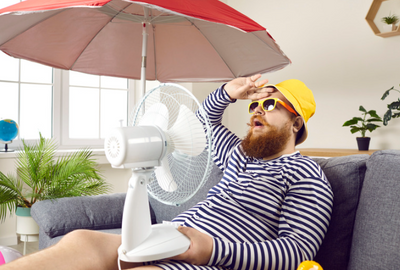
Too Hot To Sleep?
07.02.2024
It’s HOT out there, and getting to sleep when the temperatures stay high at night can be more than a little challenging.
Your bedroom feels like an oven, you struggle to keep comfortable, the air is thick and you’re torn between whether to lie on top of the duvet or risk the heat of your usual, more comfortable position underneath.
Yes, drifting off isn’t easy when it’s hot and sticky but hopefully with these top sleep tricks you’ll be able to enjoy a few more hours of sleep when the temperatures rise.
Keep Your Bedroom Cool
Start the preparations during the day by keeping curtains and blinds closed. If the air outside is cooler than inside then you should open the windows to allow the cooler air to circulate around the room. If the opposite is true, then keep your windows and blinds closed until the outside air is cool enough to let in later in the evening.
Use A Fan
If you have an electric fan be sure to use it to help circulate cool air around your body and room at night. Some people find the white noise of the fan useful for helping them to drift off to sleep.
If you find the fan distracting, use ear plugs to cut out the noise.
If it’s safe to do so, pop a bowl of cool water or an ice pack in front of the fan to cool the air even further.
Avoid Heavy Food, Alcohol and Caffeine
Eating a heavy meal before going to bed will only make it harder to sleep as digesting food actually raises your body temperature. Digestion uses energy and therefore generates heat inside your body.
Try eating cooling foods like cucumber and salad instead. These foods are largely made up of water and therefore provide hydration and anti-inflammatory properties.
Caffeine and alcohol are stimulants which are never conducive to a good night’s sleep. But when it’s hot it’s even more sensible to avoid them as they actually stimulate thermogenesis which acts to warm you up.
A cool herbal tea or just some water are much better bedtime drinks on a hot evening. Just be careful not to drink too much to avoid needing to go to the loo in the middle of the night.
Take a Shower and Use an Ice Pack
Contrary to instincts, taking a lukewarm (not cold!) bath or shower before bed will help to keep your core temperature down as it helps your blood vessels to dilate and therefore cool you down.
Cooling down pulse points on the body will also help to control your temperature. So, keep a damp cloth with a cold pack or ice bag inside it on your wrists, ankles or the back of your neck to quickly reduce the heat.
Invest in a Good Mattress
A comfortable, supportive mattress is a must for sleeping all year round but in the hot summer months when you sweat and warm up more in bed you should consider using a good sprung mattress with plenty of ventilation.
Adding a cooling mattress topper to your existing mattress will also help to provide a cooler sleeping position. A topper like the ripple mattress topper will work to help circulate the air around your body, keeping you cool and comfortable all night long.
Treat your Feet
And finally, there’s nothing nicer than a good foot spa and, when it’s hot outside and indoors, sitting with your feet in cool water for a short while before getting into bed will help to relax you and cool your temperature down nicely.
Need more help? We're always here to help so get in touch today.
For all your Medical and Homecare supplies give us a call at Mediworld.
We have over 40 years experience in medical, surgical, mobility and home health supplies and we're always on hand to chat if you need support or advice and don't forget to read our other great health blogs!
July 2022
Learn More Now
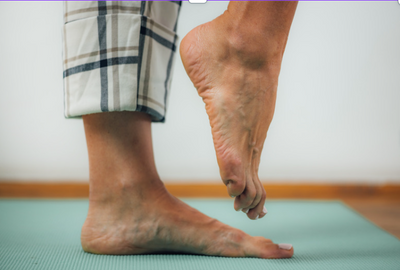
Want to Live Longer? Stand on One Leg!
07.02.2024
We recently posted on our Instagram page about a study suggesting that standing on one leg is not only good for your balance, but can be a very accurate indicator of how long you might live. The 12 year, global study examined the relationship between balance and mortality with some incredibly stark findings.
In short, it concluded that an inability to stand on one leg for 10 seconds in mid & later life predicts an almost doubling in the risk of death from any cause within the next 10 years.
The study also found that, as a population, our balance is decreasing due to our lifestyles becoming more sedentary.
The good news, though, is that we can improve our balance and, along with it, our chances of living for much longer.
Everybody Needs Good Balance
Balance is an incredibly important part of our everyday life. In fact, it is the often underrated key player in our day to day functioning.
Good balance keeps us standing upright, ensures we can walk without assistance and stops us falling over and doing our bodies untold damage.
We often take good balance for granted but without it we would find it impossible to climb steps, negotiate uneven ground, walk on grass or sand and casually step over obstacles.
Age Does Affect Balance
Unlike strength and flexibility, balance tends to stay pretty well intact until we are in and around our 60’s. At this point, however, it can deteriorate quite quickly if not kept in check.
As we age, balance becomes more of an issue and plays an enormous part in the frequency of falls and injuries sustained by elderly people. In fact, aside from car crashes, falls are the biggest cause of accidental deaths in the world and many falls happen as a result of balance failure.
Improving our good balance will not just make us more stable, it can lead to a more active life in later years and, as the study suggests, can markedly increase our life expectancy. Research has shown that good balance in older life can also lead to a better quality of life as it opens up the possibility of us becoming engaged in more fulfilling activities, both socially and physically.
Work On The Wobble
One of the best and most simple ways to improve our balance is to spend more time simply standing up. The more we sit the less we use the muscles required for balance, and the more they will deteriorate and lose their function. If we can combine standing with some simple balance exercises we’ll reap the rewards later in life.
As we get older the balance structures in our inner ear start to deteriorate and even the amount of blood flowing to our inner ears begins to change. So the odds are stacked against us.
But the more we practice the one leg stand the better we will become at it.
Have A Go At ..
...standing on a wobble board. These are fantastic bits of exercise kit designed to improve our posture, core and stability muscles, all of which are needed when balancing.
Alngside this, try standing with your shoulders feet width apart within touching distance of the wall or a chair for stability if you need it.
Raise your right leg up to hip height (as if you’re marching).
Lower it and do the same for the other side. With this move you are practicing the single leg stand.
Repeat it 10-20 times and increase the speed if you can.
Once you can do this with no support at all, you should try a simple single leg stance, working towards that 10 second goal. Don’t be afraid of the wobble - that’s fine. In fact the more you wobble, the more your body and brain will start to learn and adjust to strengthening and improving your balance.
Want to make it harder? Keep your eyes fixed on a point in the room to stop you falling over. If you can do the single leg stance with your eyes closed, then you’re absolutely winning!
Need more help? We're always here to help so get in touch today.
For all your Medical and Homecare supplies give us a call at Mediworld.
We have over 40 years experience in medical, surgical, mobility and home health supplies and we're always on hand to chat if you need support or advice and don't forget to read our other great health blogs!
July 2022
Learn More Now
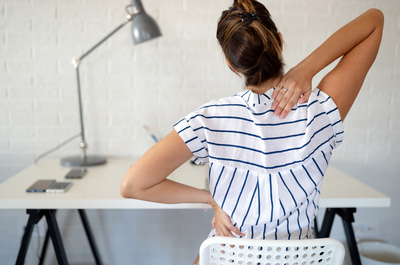
Are you suffering from Office Syndrome?
20.09.2023
You know the thing. Your job requires you to toil away in front of a computer screen all day, sitting for hours on end in the same position. Your back muscles are slowly starting to ache. Your shoulders are tight and your posture is shot to bits.
Office Syndrome is one of the biggest issues affecting desk workers in modern times. After 2 year of working from home, even more people have reported suffering from the effects of using a badly set up work zone.
The ongoing aches and pains associated with the condition affect each of us differently but thankfully there is an easy fix.
Read on to learn more about the condition and how you can prevent falling foul of it with some really easy steps:
1 in 3 people who work at a desk all day will develop a hump or curvature of the spine as a result of suffering from office syndrome.
For others, the effects of the repetitive motions of typing or mouse-use while sitting in an unhealthy posture position can be:
Carpal Tunnel Syndrome - numbing, tingling or pain due to compressed nerves in the shoulders, arms and hands.
Dyspepsia, indigestion or pain in the abdominal region
Severe Postural Back Pain
Tendinitis and inflammation of the joints in the arms and hands
Setting your workspace up inappropriately can, and often will, lead to at least some of the issues connected with office syndrome.
A chair or desk position that encourages you to hunch or slouch with rounded shoulders will cause small, subtle muscle contractions that will eventually lead to weakness in your core muscles and additional tension in other muscle groups around the body - particularly the shoulder, spine and neck.
The coronavirus pandemic has meant that flexible working has become the norm for many, who are now splitting their work time between home and the office.
So while it might be lovely to work from your kitchen table using your dining chair, or to enjoy hot-desking as part of your networking or business style, it’s never a good idea to assume that the position you’ve chosen for your working day is doing your back or your posture any favours.
Preventative Measures
Spotting the signs early that you might be suffering from office syndrome will help and you should look out for even small aches and pains in your back and abdomen, perhaps stiffness when you stand or even numb areas in your bottom and legs.
But even without experiencing any pain, it’s recommended that you take a moment to get your work station set up properly and to put some good back care practices in place as a positive, preventative measure. Think of it as an investment in your work and in your body. It might, genuinely, save you a considerable amount of money, time and pain.
- Make sure your chair allows you to sit up straight with your thighs parallel to the ground and your feet sitting flat on the floor. Your knees should bend at 90 degrees.
- The computer mouse and keyboard should be directly in front of you at a comfortable distance, with your arms supported on the desk.
- Remind yourself to regularly get up and walk around to encourage blood flow and decrease stiffness.
- Your chair should support your back and lumbar properly.
- We recommend using a back support as an accessory to your chair, to properly align your back and posture while sitting in almost any chair. The backfriend support is foldable and portable so you can use it at home, in the office or on the go while travelling in the car, train or bus.
Stop your office syndrome before it becomes chronic!!
Need more help? We're always here to help so get in touch today.
For all your Medical and Homecare supplies give us a call at Mediworld.
We have over 40 years experience in medical, surgical, mobility and home health supplies and we're always on hand to chat if you need support or advice and don't forget to read our other great health blogs!
Learn More Now

5 Ways to Instantly Improve Your Nutrition this Month
07.02.2024
We all know how important a good diet is to maintaining good health and well being. We also know that eating fresh fruit and vegetables every day is imperative to establishing a diet that’s rich in all of the nutrition we need to stay healthy.
The general guidance is that fruit and veg should take up half of our daily plates, with grains, protein and dairy accounting for the other 50%. If you sometimes find it difficult to include enough of the good stuff into your diet (and let’s face it, with Easter Eggs and Ramadan currently on our minds, it’s very hard to stay on track!) it might be a good idea to just focus on adding a few really tasty fruits and vegetables into your diet each week.
So, as spring has sprung, here’s our guide to the 5 best fruits and vegetables to fill your shopping baskets with this month.
Asparagus
Asparagus, in the UK, is in season from April to June so now is the best time to add it to your diet. Like most green vegetables it’s full of antioxidants, as well as Vitamins C and E. It’s believed to have anti-inflammatory properties which make it a natural food supplement for people who suffer from conditions like arthritis or mobility issues.
A portion of asparagus will provide you with 5% of your daily potassium needs and, if eaten in conjunction with a low salt diet, will help towards reducing your blood pressure as well.
Roast the asparagus spears in the oven and eat it alongside meat and fish, or add it to pasta, stir fries, salads or omelettes.
Spinach
We know it’s not to everybody’s taste but Spinach is one of the best green vegetables you could add to your diet today. Some people love it raw while others prefer to eat it cooked or ‘hidden’ in smoothies, fish cakes or vegetable bakes and curries
Spinach is loaded with protective compounds called polyphenols which are thought to include cancer-preventing properties (studies have shown that it is particularly effective against colon cancers). The Vitamin K and magnesium in spinach provide essential support for healthy bones and its dark green leaves contain high levels of chlorophyll and carotenoids which help to prevent eye conditions like cataracts and macular degeneration.
Feeling a tad run down? Well, Popeye was right - spinach really does help. While it doesn’t contain quite as much iron as initially thought when the cartoon makers came up with the strong-man character, spinach does have enough iron in it to help with boosting red blood cells as they transport oxygen around the body and provide extra energy to our bodies when they need it.
Mushrooms
There are a huge variety of mushrooms and ways to eat and cook them. They’re an incredibly versatile vegetable used more and more as meat substitutes for vegans, vegetarians and just those looking to cut down on their red meat consumption. If you’re cutting down on your meat, you could try blending chopped mushrooms with minced beef to make a burger with less fat and fewer calories than the full meat version. Or a grilled, full portobello mushroom makes for a delicious vegetarian burger option.
Mushrooms are great sources of prebiotics and help to promote good gut bacteria. It’s becoming apparent that a good gut environment is crucial to maintaining a good immune system and a healthy brain & nervous system.
There is also evidence that some varieties of mushrooms (which are most often consumed in tablet or powder form) are beneficial in the treatment of neurodegenerative diseases including Alzheimer’s and dementia conditions.
Rhubarb
Although it’s technically a vegetable, rhubarb is more often used and cooked like a fruit. After growing throughout the winter, rhubarb is coming into its own just now and is in bountiful supply at this time of year. It’s a great source of antioxidants and Vitamin K and it’s full of natural fiber which has been shown to help reduce cholesterol levels.
Stew it and add to breakfast cereal, yogurt or porridge or make it into jam, compote or even as a flavouring to drinks and cordials. Remember the leaves are toxic so don’t be tempted to eat or leave them on while cooking.
Bananas
This household staple is loaded with potassium, vitamin B6, folate and fiber and one banana will easily give you 1 of your 5 a day. Try adding a banana to your next smoothie, or slice one and add oatmeal, cereal and peanut butter toast.
Feeling a bit down? Bananas contain tryptophan, an amino acid which the body converts to the feel-good brain chemical serotonin. Eating a banana will help the brain to relax, improve mood, lessen anxiety and generally make you feel happier.
Unripe bananas can also help to neutralise stomach acid and are a useful dietary addition for those with heartburn - just be sure to eat them when they’re green/under ripe for the most effective results.
So, this spring why not commit to adding some new seasonal fruit and veg to your diet. Trying new foods, whether raw or cooked, is a great way to keep your meals interesting and ensure you meet your daily nutrition needs.
Need more help? We're always here to help so get in touch today.
For all your Medical and Homecare supplies give us a call at Mediworld.
We have over 40 years experience in medical, surgical, mobility and home health supplies and we're always on hand to chat if you need support or advice and don't forget to read our other great health blogs!
April 2022
Learn More Now

Looking After Your Heart and Lungs in Cold Weather
12.02.2024
We had an incredibly mild festive season but now much of the UK is experiencing a massive drop in temperatures. Frosty mornings and snow on higher ground might make for stunning landscapes and seasonal weather but the cold snap can also bring some serious concerns for those who are vulnerable to heart, lung and respiratory conditions.
Sudden drops in temperature can trigger a flare-up of symptoms if you suffer from a lung and heart condition, making you more vulnerable to illness.
Thankfully there are things you can do to look after your heart & lungs this winter.
How does the cold affect my heart and lung condition?
When it’s cold outside, the body naturally goes into ‘warm up’ mode, working extra hard to pump more blood around to keep warm and functioning well. This extra effort means that your heart will beat faster and your blood pressure will go up, putting additional stress on your vital organs, especially the heart and lungs.
For those with heart conditions, the sudden extra work your body has to do could cause serious repercussions and could, in some cases, lead to heart failure.
Cold air can also impact your breathing. Cold air can trigger spasms in the lungs, making breathing much harder and creating the conditions for an asthma attack or severe coughing and chest tightness and wheezing.
So it’s essential that you take extra precautions when out and about in cold weather this winter.
Looking after your heart and lungs
Keeping warm is the first and most obvious thing you need to do to protect your heart and lungs in the winter.
- Check the weather before venturing outside.
- Wrap up warm, covering your chest area with layered clothing and a scarf around your neck. Keep your extremities covered with gloves, thick socks and wear a warm hat to prevent heat loss.
- Breathe through your nose, as the incoming air will have a greater chance to warm up before reaching your lungs this way. And if you can, cover your mouth and nose with your scarf or a snood-type garment to protect your lungs and airways from the cold air.
- Keep moving but do not be tempted to do too much. Your heart will already be under pressure as it is pumping extra blood around your body, so any extra requests to work even harder could lead to sudden pain or even heart failure.
- The cold air can tighten your airways so if you use an inhaler, you might want to administer a dose around 15minutes before going out (be sure to follow your own GP/Specialist guidelines on this) and carry it with you when outside.
Avoid colds and flu
Keep your distance from anyone suffering from a cold, flu or, of course, coronavirus. Cold and flu infections spread very easily and your condition will make you extra vulnerable to them. You should tell your friends and family that if they have a cold or flu they shouldn’t visit. This can be hard, but it’s important to look after your own health
Make sure you’re up to date with your flu and covid vaccinations to give yourself the best protection against those viruses.
Keep Active
Try to stay as mobile and active as possible. Sedentary living will make it harder for you to keep warm in the winter months.
Get up and move around regularly, or if you’re in a chair or bed, try to move your upper body or do some strength exercises as you can.
Set an alarm to remind you to get up every hour - a Talking Memo Watch is fantastic for this as it can be set to go off every hour and allows you to record an alarm reminder message to yourself. Give yourself some household tasks to do every hour to keep you motivated to stay active.
The NHS website has some fantastic resources to help you keep active at home.
Keep Warm at Home
Heating your home to around 18°C (or 64°F) should provide enough comfort and heat to keep your heart and lungs happy. You might want to heat just the room you spend most time in to save money and impact on the environment.
While you’re sitting or busying yourself around the house you could use a discreet hot & cold pack waist belt which wraps comfortably around your waist or back and keeps you warm with the reusable hot and cold packs inserted in the belt.
At night, when the temperature tends to fall to its lowest point, you will want to keep your bed and bedroom as snug and comfortable as possible to allow for good breathing while you sleep.
Heating your bedroom to 18°C (or 64°F) an hour or so before bedtime will bring it up to a nice temperature for sleeping. If you’re turning the heating off through the night or if you like a warm bed you might want to also use a heated mattress cover which works on a number of different heat settings and has a low energy consumption for night time use.
If you need help with heating your home the British Lung Foundation has a fantastic resource page filled with details of the benefits and warm home payments available just now in the UK.
Need more help? We're always here to help so get in touch today.
For all your Medical and Homecare supplies give us a call at Mediworld.
We have over 40 years experience in medical, surgical, mobility and home health supplies and we're always on hand to chat if you need support or advice and don't forget to read our other great health blogs!
January 2022
Learn More Now
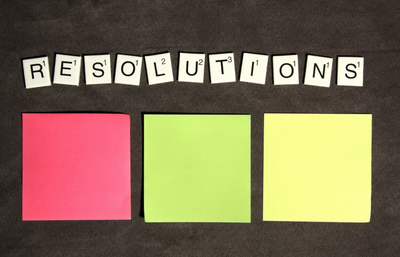
Easy Resolutions for a Healthy 2022
26.09.2023
It’s that time of year again when we start to consider how to improve our life for the coming year ahead, when we start to make New Year resolutions to be more pro-active with our health and wellbeing.
Let’s face it though, we’ve all been here before and we know that sticking to a new, health regime can be daunting and many of us will have failed only weeks into the new year.
So, here are some ideas for how you can set some reasonable health goals for 2022 and how you can stick to them so you’ll be a healthier version of you this time next year.
Create a Realistic Goal
With any resolution you need to start with asking yourself what it is you actually want to achieve. Where do you want to be in 12 months time? What mini goals can you achieve along the way? And how can you achieve those and mark them with rewards or ceremony?
As they say, stay in your own lane and don’t be intimidated by other people’s resolutions. Yours should work for you and you only.
Write it Down
Whatever that goal is, write it down! Pin it to your noticeboard or to the fridge door. Make a commitment to the goal and to yourself.
Print out or make a progress chart so you can tick off the days/weeks/months and easily see your achievements. And don’t stress about set backs or days off - it’s the overall progression that’s important.
Keeping going in the right direction is all that matters with health goals.
Always Active
If you make just one resolution this year it should be to be more active. Adding just 10 minutes of extra activity to your day is one of the best things you can do for your health this year.
However, unless you’re in the elite athlete category, or you’re young and super fit, you might not be setting major goals like running a marathon or climbing the 3-peaks!
So keep your goals simple.
Maybe plan to walk for 10 minutes every day or to dust off the bike in the shed and cycle for 20 - 30 minutes a couple of times a week.
You might be in a wheelchair or your mobility is challenged in some way, and your goal might be to increase body strength or flexibility.
Simple Solutions = Successful Resolutions!
Once you’ve set your goal why not treat yourself to something that will make it easier to achieve?
If you’re planning to walk more, a simple solution to making it more comfortable is to use some cushioned silicone insoles.
Want to be more active while you’re sitting at a desk all day? A pedal exerciser sits neatly under the desk and allows you to pedal away while you’re sending those emails and writing those documents.
Or if you finally want to improve your back pain, an easy to use posture brace can help to ease your pain and get you sitting and standing better with less rounded shoulders.
Learn to Love your Bed
Here’s an easy one to implement.
Getting better sleep isn’t always as straight forward as we’d like and many of us suffer from insomnia or restless night caused by ill health, menopause or even stress. Working on dealing with these problems should definitely be a goal for 2022, perhaps just setting a target to begin the process if you think the end result of uninterrupted sleep is a long way off.
But improving your relationship with your sleeping space can be easily solved, and that’s a great first step to achieving better sleep in the long run.
Have a good clear out of your bedroom, make it a calm space to be in. Invest in a good mattress topper and memory foam pillow or V-shaped Pillow to get super comfy and make your sleeping space a place you want to spend time in.
Nourish Your Mindset
We like this one. Not only does committing to this one help to boost your mind and mental wellbeing but, hopefully, it will give you a list of great activities and memories by the end of 2022.
Explore your passions, take up new interests, visit new places and engage with those you love and those you are yet to meet.
Why not give yourself 12 goals - one for each month - that will improve your social well being or will engage you in a new task or interest. Try ideas like crafts, crosswords, yoga, museums & galleries, time with family or committing to finally reading (or writing!) that novel you’ve had in your mind. Set a monthly ‘challenge’ with one of these activities in mind, write it down, plan it, make a date with yourself and see how they improve your life as the months tick by this year.
Resolutions Should be Fun
Enjoy making those goals and make those goals enjoyable! When your goals really matter to you they become much easier to achieve and they’ll begin to influence everything you do. Staying realistic about what you can achieve will help you to get there.
What could be a better way to live in 2022 than that?
Need more help? We're always here to help so get in touch today.
For all your Medical and Homecare supplies give us a call at Mediworld.
We have over 40 years experience in medical, surgical, mobility and home health supplies and we're always on hand to chat if you need support or advice and don't forget to read our other great health blogs!
January 2022
Learn More Now
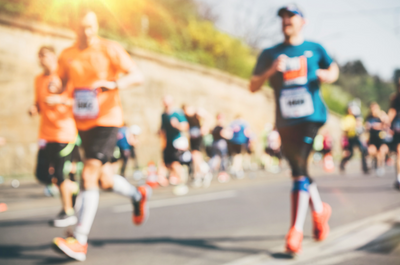
Marathon Recovery Tips
26.09.2023
First off, let us congratulate you! You ran 26.2 miles. That’s a huge achievement and, hopefully, you’re still basking in a sea of endorphins and a great sense of self pride. But your legs hurt. Your knees are starting to stiffen up and your toenails are starting to look like they might not hang around for much longer.
Time to start focusing on good marathon recovery? Yes. Every recovery is different but here are some useful tips to follow in the week after your marathon to help speed up yours so you can get on with thinking about your next big challenge.
Stay cool
As lovely as the idea of a hot bath is, don’t be tempted to hop in for a long, steamy soak quite yet. You’ll be experiencing some considerable inflammation in your joints after running such a long way, so soaking in cold, or even iced, water for 5 - 10 minutes will be much more useful in helping to reduce the inflammation.
If you have particular ‘hot spots’ of pain, for example on your hips, hamstrings, knees or glutes, you can use an ice pack or ice bag to address those specific areas. Apply the cold pack to the sore area for up to 10/15 minutes several times throughout the day and throughout the following week to aid recovery and reduce any swelling.
Raise your Legs
Take 10 minutes each day in the week after your marathon to lie on your back and raise your legs against a wall. This popular yoga exercise is a quick and easy way to refresh tired legs, prevent fluid ‘pooling’ in the lower legs and to help improve the blood circulation.
If your legs are feeling particularly sore or tired, and you find yourself on your feet a lot, say at work, in the days after your marathon you might want to wear a discreet compression sock or compression stocking. These are designed to improve blood circulation by gently squeezing the leg and pushing the blood back towards the heart. They’re also great to use as a preventative measure (or supportive tool) for varicose veins.
Sleep
It might seem obvious but one of the best ways to ensure your body can repair and recover is to make sure you get plenty of sleep this week. BUT don’t be tempted to spend long, lazy days lying around as too much inactivity will be counterproductive and your sore muscles won’t thank you for not giving them the chance to move around. Aim for at least 8 - 9 hours sleep each night in the week after your marathon.
Another great addition to your post marathon recovery strategy is a foam leg raiser which can be used while you’re lying down in bed or taking a short nap/rest. The leg raiser is designed to support swollen legs, ease back pain and stimulate circulation.
Eat Well
Immediately after your marathon you should be making sure you keep hydrated and try to have a small, protein-filled snack like some nuts, a protein shake or recovery bar. Your aim is to eat good proteins and carbohydrates to keep your blood sugar levels up, replenish muscle glycogen and start to repair any damaged muscle tissue. Later in the day you can definitely enjoy a slap up meal - you’ve worked hard for it! Just keep hydrated and try to avoid alcohol or too much caffeine.
As the week continues make sure you keep up your protein intake to continue to repair those muscles.
Massage
While foam rolling and stretching are both must-do activities around 4-5 hours after your marathon has ended, you’re probably desperate to start massaging those tired and aching muscles. But, don’t be tempted to book your favourite massage therapist or start using your massage gun too soon. Wait at least 24 or even 48 hours before starting to work on your muscles with massage techniques to give them time to rehydrate and reduce any swelling.
A few days after your marathon you can get out your massage therapy gun and get working on those sore areas of your body. By then you’ll have a better idea of what is really feeling tight and which areas might need the most work. You should seek professional help from your physiotherapist or osteopath if you’re feeling extreme pain or discomfort. They can help to diagnose any injury and provide a good rehabilitation programme.
If, however, you’re simply feeling tight and after your run then you’ll want to invest in a good massage gun - and you can read our recent blog on what massage gun to buy and how best to use it.
Glory
Finally, make sure you enjoy the enormous feeling of accomplishment this week. Whether you’ve just run your first or your fiftieth marathon it’s something to be very proud of. Enjoy your moment, look after your body and allow yourself to take a week, or even two, out to rest, recover and pat yourself on the back!
Need more help? We're always here to help so get in touch today.
For all your Medical and Homecare supplies give us a call at Mediworld.
We have over 40 years experience in medical, surgical, mobility and home health supplies and we're always on hand to chat if you need support or advice. Follow us on Twitter and Facebook and don't forget to read our other great health blogs!
Learn More Now

How does age affect your brain health?
07.02.2024
We know that as we age we start to lose brain cells and many of us will have to face the prospect of developing dementia or Alzheimer’s. The human brain is a fascinating and mysterious part of our anatomy and one we still have a lot to learn and discover about.
That said, while we can’t avoid getting older, keeping our cognitive function in good condition as we age is something we can actively pursue.
Brain Health
Good brain health is as important as good physical health because the brain is responsible for our:
Motor function - balance and movement
Cognitive function - learning, thinking and recalling memories
Emotional function - the entire range of emotions we use to respond to scenarios
Tactile function - our ability to react and respond to touch, pressure and temperature
Daily Brain Workout
Looking after our brains as we age is crucial. While some medical conditions and lifestyle factors can increase cognitive decline, for many of us spending just a few minutes on concentrated ‘brainwork’ each day can help to keep our minds in tip top condition, delaying or even preventing serious brain deterioration.
Active brains start with active bodies
As with so many things in life, regular physical activity is the key to overall health. A fit and healthy body is more conducive to an active mind than a sedentary, unfit one. Not only that, learning a new skill or piece of information via a physical activity can help you to retain the information even more easily. Why not try these short bursts of activity each day to get your cognitive juices flowing?
Throw and catch a ball.
Juggle
Concentrate on manual dexterity with a squeeze or stress ball
Take stairs or walk over uneven ground (if able).
Count and calculate the distance you’ve walked/score on the dartboard etc
Play bowls, golf, mini golf, bocce, quoits, croquet (if able).
Try arts and crafts projects.
Exercises like these are fantastic for increasing blood flow to the brain and protecting against cognitive degeneration. They use your cognitive ability, motor function, tactile function and are great at creating new neural pathways.
Mind Games
Similarly, playing games like scrabble, jigsaws, chess, card games and charades can create new neural pathways and help to stave off cognitive decline. Although these games are played without physical activity they are still incredibly good ways to keep your brain in peak condition. Mental maths, crosswords and sudoku are equally fantastic.
Keep it Social
Staying connected to others is another way to improve cognitive condition. A solitary life offers much less stimulation than one that includes socialising. In fact loneliness is incredibly detrimental to our brain functions and has been shown to be as bad for our overall health as smoking 15 cigarettes a day!
Do your best to join some local interest clubs - walking, dancing, arts & crafts, historical societies etc. Learn a new skill - maybe sign up for a local college evening class. Perhaps consider offering your time to a local charity - where your job might involve organising events/stock/finances etc. Maintain regular conversations with family and friends.
Need more help with staying healthy at home? We're always here to help so get in touch today.
For all your Medical and Homecare supplies give us a call at Mediworld.
We have over 40 years experience in medical, surgical, mobility and home health supplies and we're always on hand to chat if you need support or advice. Follow us on Twitter and Facebook and don't forget to read our other great health blogs!
Learn More Now

Easy Tips for a Healthy Heart
20.09.2023
In the course of our lives our hearts will beat around 2.5 billion times. Second after second, day after day, year after year. The heart is the most vital of organs for keeping us alive and well, so it’s crucial that we understand the importance of living a heart-healthy lifestyle.
Heart disease is the number one cause of death in the UK, with over 170,000 deaths per year being attributed to heart and circulatory disease. Yet, most premature deaths caused by heart disease are thought to be preventable. So, how should we best look after our heart to avoid becoming a statistic in the UK’s increasing number of deaths by preventable heart condition?
Lose Weight
Resolving to bring your weight down is one of the best things you can do for your heart. When you’re overweight your heart has to pump harder to deliver blood to a growing network of arteries in an increasingly large body. Over time the heart struggles, the muscles become thicker and the risk of developing heart failure increases.
Being overweight also increases the risk of:
Stroke
Heart Disease
Blood clots
High cholesterol
Hypertension
Sleep Apnea
Diabetes
Lose weight by following a healthy diet and a regular, gentle exercise regime. We know it’s incredibly hard to change your lifestyle, but breaking it down into small changes (like adding extra minutes of exercise each day or slowly lowering your calories) that you maintain over a long period of time will gradually result in weight loss and a healthier lifestyle. It takes just 60-90 days to form a lifetime habit, so if you can stick with it for just that long you’ll have made some incredibly effective changes to the health of your heart.
Improve your sleep
Good quality sleep plays a huge part in your overall health and wellbeing. If you’re running low on sleep you’re at risk of developing heart failure, hypertension, overeating and increased blood pressure.
As well as making sure your bed and bedroom are comfortable, there are plenty of fantastic sleep resources online to help you get into a good pattern of sleeping well. Our top tips for getting a good night’s sleep include:
Limiting your napping during the day (and don’t nap after 1pm)
Cut back on caffeine, especially after lunchtime, and avoid other stimulants including nicotine
Eat your meals at a regular time, with your main evening meal no later than 2 hours before bed time
Stay active! Make sure you have some gentle exercise for at least 20-30 minutes everyday (just not too close to bedtime)
Ditch the screens and put your phone, laptop or tablet away before bedtime. Never take your screens to bed.
Make sure you’re completely comfortable in bed (maybe try using one of these pillows ).
Stop Smoking
If you’re a smoker your risk of developing heart disease or dying from heart failure is four times greater than that of non-smokers. Every cigarette you smoke makes you more likely to develop heart problems, and roughly 1 in 5 deaths from heart disease is directly attributed to smoking.
The nicotine in cigarettes is extremely damaging to you and to anyone receiving passive smoke from your habit. It can:
Reduce the oxygen flow to your heart
Raise your blood pressure
Speed up your heart rate
Increase the chance of blood clots, which lead to heart attacks and strokes
Harm the inside of your blood vessels and your heart.
If you stop smoking, your odds of developing heart disease drop significantly. In fact, just 1 year after you quit your risk of developing heart disease will have halved and will continue to decrease as the years go on.
Reduce your stress
Stress poses huge risks for us all and in our modern society it’s incredibly difficult to avoid. However, we know that highly anxious people are more likely to suffer heart attacks and strokes, so reducing our levels of stress and worry can be a very effective way to prevent that outcome.
Take time in your day to do something that relaxes you might seem like a very low priority, but remember that if we prioritise our health everything else become much easier to manage. Try going for a walk, reading a book, exercising or volunteering to help someone.
Perhaps download a meditation app with a reminder to take 15 minutes each day to relax your breathing, lower your shoulders, and reset your feelings.
Reducing your caffeine, alcohol and stimulant intake will also help to reduce your body’s stress levels very effectively.
Need more help? We're always here to help so get in touch today.
For all your Medical and Homecare supplies give us a call at Mediworld.
We have over 40 years experience in medical, surgical, mobility and home health supplies and we're always on hand to chat if you need support or advice. Follow us on Twitter and Facebook and don't forget to read our other great health blogs!
Learn More Now

Is Sitting Down Bad for You?
24.07.2023
Apparently we spend at least half of our life sitting down. And modern society seems designed to encourage us to sit as much as we possibly can. Think about all those squishy sofas, bean bags, recliner chairs and street furniture around us all day long. Whenever we get the chance it seems we like to take a seat.
But is sitting down bad for us and if so, what can we do to lessen the time we spend on our backsides?
What damage does sitting down do to our health?
Leading a sedentary lifestyle is, without doubt, very detrimental to our health. In fact, it would be fair to say that choosing a lifestyle where you sit for too long without any activity will kill you.
Research shows that the less active you are the more likely you are to develop long-term health issues and to significantly lower your life expectancy.
What happens when we sit for too long?
People who sit for long periods of time, with little or no breaks for exercise or activity, put themselves at a higher risk of these potentially life threatening conditions:
Weight gain - sitting for long periods means you will be less active and as a result you will burn fewer calories. If you’re not using your muscles or your cardiovascular system your body will be less able to efficiently process the fats and sugars you eat in your diet, leading to weight gain and eventually obesity.
Diabetes - Studies have shown that long periods of sitting can trigger the body into resisting insulin, which is an early indicator of the onset of diabetes. People who spend more time sitting are found to have a 112 % increased chance of developing diabetes.
Deep Vein Thrombosis and Varicose Veins - While varicose veins are largely superficial, they can be unsightly and, on occasion, cause mild, irritating pain. DVT is a much more serious consideration. With DVT a blood clot can appear most often in the legs, and cut off the regular blood flow through the veins, into the lungs and can cause serious blockages and embolisms.
Bad posture and back pain - Almost all of us will sit with bad form causing our spine, shoulders and hips to weaken and ache. Sitting down causes your hip flexors to tighten and shorten, and over time the back and spine can become hunched, weak and prone to disc issues, degeneration and chronic pain.
What happens when we add regular movement to our day?
Research shows that regular movement throughout the day leads to
Better health
Increased motivation
Improved concentration
And many, many more wellbeing and performance benefits
Ways to convert sitting time to standing time
Get up, stand up - feel good! That’s the mantra you need to repeat to yourself each day.
Whether you work at a desk for 8 hours a day or you find that on your leisure time you’re unhealthily attracted to the sofa, making simple changes to your day is easier than you think.
Why not try some of these ideas to get up onto your feet?
Stand up when making phone calls
Stand and take a break from your computer or television every 30 minutes (and don’t use that time to head straight to the fridge!)
Use the stairs whenever you have the option
Go for a daily walk - put it in your diary and stick to it. If you’re working why not have a walking meeting with a colleague.
Walk to a colleague's desk instead of phoning or emailing them
Stand at the back of the room during presentations
For all your Medical and Homecare supplies give us a call at Mediworld.
We have over 40 years experience in medical, surgical, mobility and home health supplies and we're always on hand to chat if you need support or advice. Follow us on Twitter and Facebook and don't forget to read our other great health blogs!
Learn More Now

Eye Health in Older Age
07.02.2024
We know that it’s very likely our vision will begin to deteriorate as we age, and many of us will need to wear reading glasses at some point in later life, if not before. But looking after your eyes should be high on your list of health and wellbeing maintenance.
Aside from making it difficult to read, vision problems can lead to a higher risk of falls, driving accidents & disorientation as well as making day-to-day life that bit harder.
So, the best way to see to it that your eyes are in good health, is to regularly have them checked at the optician, where poor vision and common health issues can be picked up and treated before they become a problem.
What eye conditions might I suffer from as I age?
The most common conditions that affect our eyes as we age are:
glaucoma
cataracts
macular degeneration
Some conditions like glaucoma will have few, or no, symptoms but can eventually lead to sight loss. So regular checks are important to catch them early.
When should I have my eyes tested?
As a rule, you should book an eye test every two years while your eye health is in good shape. See this as an important part of your general health checks and MOT - like having a smear test, or going to the dentist for a check up. Put it in your diary and make sure you stick to it.
Your optician will be able to pick up any issues that may arise with your eyes - but also with your health in general.
You might be surprised to hear that your optician can often be the first to detect conditions like diabetes, arthritis, dementia, cardiovascular disease and tumours. So it’s really important that if you notice any changes in your vision you should have it checked as soon as possible.
Is an eye test expensive?
A basic eye test is reasonably inexpensive at around £20 - £30. Everyone over the age of 60 is entitled to a free eye test every 2 years, and if you suffer from certain medical conditions (including diabetes) you will be given free, regular eye tests.
You could also be eligible for free or discounted glasses, if you are on a low income.
Top tips for keeping your eyes healthy
As well as regularly having your eyes tested you should:
Wear sunglasses to protect your eyes from the sun.
Eat healthily! Lots of fresh fruit and veg in your diet is great for your overall health as well as for keeping your eyes in tip top shape.
Stop smoking! Smoking is harmful to eyes – research has shown that smoking increases the risk of age-related macular degeneration, glaucoma and cataracts. Cigarette smoke irritates the eyes and will worsen dry eyes.
Extra visual aids to help with reading
If you’re struggling to read or see the details on your computer screen or television then there are a number of great optical and visual aids and gadgets that you can use to help improve your vision and keep you living independently.
These include:
computer screen magnifiers
Hand held magnifying glass for reading
big button telephones
Large digit watches
large print books and newspapers
talking books
Nail clippers with magnifying glass
large print playing cards and board games
screen readers
talking watches
As well as these you should ensure your at-home lighting is good enough to help you see better. Simple things like opening curtains and blinds to let sunlight in during the day and using a good flexible reading lamp in the evenings will help enormously.
Need more help with finding visual aids for the home? We're always here to help so get in touch today.
For all your Medical and Homecare supplies give us a call at Mediworld.
We have over 40 years experience in medical, surgical, mobility and home health supplies and we're always on hand to chat if you need support or advice. Follow us on Twitter and Facebook and don't forget to read our other great health blogs!
Learn More Now
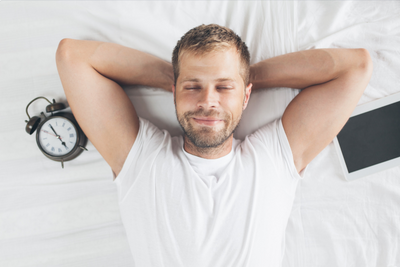
How to sleep better at night naturally?
07.02.2024
Sleep is vital to our overall well-being. It affects both our physical and mental health. With inadequate sleep comes numerous health issues, including; fatigue, a weakened immune system, and cognitive decline.
However, many people need help to achieve quality sleep every night. This comprehensive guide will explore why people often struggle to sleep and discuss various techniques to improve sleep naturally, so you can wake up refreshed and rejuvenated every morning.
Why Can't You Get Good Sleep?
Sleep quality is easily disturbed. The most common factors include stress, an inconsistent sleep schedule, an uncomfortable sleep environment, and lifestyle factors such as diet, exercise, and stimulant intake.
One can significantly improve their sleep and overall health by addressing these factors and implementing strategies to overcome them.
How to Sleep Better at Night Naturally?
Adopting specific habits and practices that promote a conducive sleep environment and encourage relaxation is essential to sleep better at night naturally. Here are some helpful tips to optimize your sleep and rest more peacefully throughout the night.
1. Consistent Schedule
Establishing and maintaining a consistent sleep schedule can significantly improve sleep quality. Going to bed and waking up at the same time every day, including weekends, helps regulate your body's natural sleep-wake cycle, making it easier to fall asleep and wake up refreshed.
2. Bedtime Routine
Developing a relaxing bedtime routine can also enhance your ability to fall asleep quickly and sleep more soundly. Calming activities like taking a warm bath, practising deep breathing, reading a book, or practising gentle stretches can help your mind unwind and signal your body that it is time to sleep.
3. Sleep Environment
Creating a comfortable sleep environment plays a crucial role in achieving restful sleep.
Your sleeping area should be tranquil, dimly lit, and without interruptions. Sleep-enhancing tools such as light-blocking drapes, earplugs, or sound machines can assist in minimizing disturbances from outside noise or lights.
Additionally, invest in a quality mattress and pillow that provide optimal comfort and support for your body.
4. Stress Management
Managing stress and anxiety is vital for achieving better sleep. Incorporate relaxation techniques such as meditation, yoga, or deep breathing exercises into your daily routine to help alleviate stress and calm your mind before bedtime.
5. Limit Stimulants
Avoid consuming stimulants such as caffeine, nicotine, or alcohol close to bedtime, as they can interfere with your ability to fall asleep and stay asleep. Instead, opt for caffeine-free herbal teas or warm milk, which can induce relaxation and promote sleepiness.
6. Regular Exercise
Engaging in regular physical activity can significantly improve sleep quality. Exercise can help alleviate stress, tire the body, and regulate sleep patterns. Aim for at least 30 minutes of moderate-intensity exercise daily, ideally in the morning or afternoon, as exercising too close to bedtime can stimulate the body and make it more challenging to fall asleep.
7. Balanced Diet
Eating a balanced diet rich in nutrients is crucial for achieving restful sleep. Consuming foods high in magnesium, calcium, vitamin D, and tryptophan can promote sleepiness and relaxation. Avoid heavy or spicy meals close to bedtime, as they can lead to discomfort and disturb your sleep.
8. Relaxing Ambiance
Create a relaxing ambience in your bedroom by incorporating soothing scents, soft lighting, and calming colours. Using essential oil diffusers with lavender or chamomile can induce relaxation, while dimming the lights or using warm-toned light bulbs can create a peaceful atmosphere conducive to sleep.
9. Sleep Hygiene
Maintaining proper sleep hygiene is essential for restful sleep. Ensure you change your bedding regularly, clean your bedroom, and wear comfortable pyjamas. Good sleep hygiene practices can contribute to a more conducive sleep environment and encourage better sleep habits.
10. Natural Aids
Consider incorporating natural sleep aids like herbal teas, supplements, or essential oils into your bedtime routine. Options such as valerian root, melatonin, or chamomile tea can help promote relaxation and improve sleep quality without prescription medication.
11. Lighting Control
Controlling the amount of light in your bedroom can significantly impact your ability to fall asleep and sleep soundly. Exposure to bright or blue light from screens like smartphones, tablets, or televisions can suppress melatonin production and disrupt your sleep-wake cycle.
Remove electronic devices from your bedroom and avoid screen time for at least an hour before bed to optimize your sleep environment.
12. Fluid Intake
Monitoring your fluid intake in the evening can help prevent disruptive sleep due to the need for frequent bathroom visits. While it's essential to stay hydrated, limit fluids two hours before bedtime, focusing on consuming most of your daily water intake earlier in the day.
13. Tech Assistance
While avoiding screen exposure before bed is essential, specific tech tools, such as sleep-tracking apps or white noise machines, can help improve sleep quality. Sleep tracking apps can provide insights into your sleep patterns and identify areas for improvement. At the same time, white noise machines can mask external noises and create a soothing sleep environment.
14. Temperature Control
Your sleep quality can be significantly influenced by the temperature of your surroundings. As a rule of thumb, a slightly chilled room (about 65°F or 18°C) encourages better sleep by supporting the body's innate cooling mechanism during sleep.
Try varying the room's temperature to find your ideal setting, and consider opting for bedding materials that allow air circulation to ensure a cosy sleep environment.
15. Quality Mattress
Investing in a quality mattress that provides proper support and comfort can enhance your sleep quality. A mattress that aligns with your preferred sleep position and alleviates pressure points can minimize sleep disturbances and ensure a restful night's rest.
Why is Good Sleep So Important?
Sleep plays a vital role in maintaining overall health and well-being. Numerous physiological and psychological processes occur during sleep, contributing to the proper functioning of the body and mind. Here are some reasons why getting good sleep is essential for overall health:
1. Physical Rejuvenation
During sleep, the body undergoes a process of repair and rejuvenation. Damaged cells are repaired, and muscles and tissues are rebuilt. This regeneration process keeps the body in optimal condition. It ensures that daily wear and tear is effectively addressed, allowing the body to heal from daily stressors.
2. Enhanced Immune Function
Adequate sleep is crucial for maintaining a healthy immune system. During sleep, the immune system produces cytokines essential for defending the body against infections and inflammation. A lack of sleep can weaken the immune system, making a person more susceptible to illnesses and increasing recovery time.
3. Improved Memory and Learning
Sleep plays a critical role in the consolidation of memory and learning. During deep sleep, the brain processes and consolidates information acquired during the day, helping individuals retain knowledge more effectively. This process enhances cognitive function, improving new information retention and problem-solving abilities.
4. Regulated Mood and Emotions
Sleep is closely associated with emotional regulation. The brain processes emotions during sleep, allowing individuals to maintain emotional stability and respond effectively to daily challenges.
Poor sleep can cause mood swings, increased irritability, and higher susceptibility to stress, anxiety, and depression.
5. Increased Focus and Concentration
A good night's sleep can improve focus and concentration, allowing the brain to recharge and optimize cognitive function. Sleep not only helps consolidate information but also plays a role in clearing toxins from the brain, further enhancing cognitive performance.
People who get sufficient sleep are less likely to experience lapses in focus and concentration during the day, resulting in better productivity and overall performance.
6. Reduced Risk of Chronic Diseases
Numerous studies have shown that adequate sleep reduces the risk of developing chronic diseases like diabetes, heart disease, and obesity. Insufficient sleep can lead to insulin resistance, increased inflammation, and poor cardiovascular health, all of which can contribute to chronic health problems. Good sleep patterns can protect against these risks, helping to maintain long-term health.
7. Enhanced Athletic Performance
Sleep has a significant impact on an individual's physical performance. Adequate sleep is associated with improved reaction times, increased endurance, and enhanced muscle recovery. Athletes who get enough sleep are better equipped to perform at their best and recover more effectively after intense training sessions.
8. Balanced Hormone Levels
Sleep is essential for maintaining the proper balance of hormones responsible for growth, metabolism, and immune function. While we sleep, the body releases growth hormones. It regulates the production of leptin and ghrelin – hormones that control hunger and satiety.
A lack of sleep can throw off hormonal balance, leading to poor appetite control, slowed metabolism, and reduced immune function.
9. Repair and Growth of Tissues
During sleep, the production of growth hormones increases, promoting cell growth and the repair of tissues throughout the body. This process is essential for healing injuries, maintaining the integrity of muscles and joints, and preventing the breakdown of crucial proteins.
Consistent and restorative sleep ensures the body's structural components remain solid and healthy.
10. Optimal Metabolism and Weight Management
Adequate sleep is crucial for maintaining a healthy body weight, as it influences various aspects of metabolism. Poor sleep can lead to hormonal imbalances that increase appetite, promote fat storage, and impair insulin function.
People who consistently get enough sleep are more likely to maintain a healthy weight and have a balanced metabolism, reducing their risk of developing weight-related chronic diseases.
Conclusion
Good sleep is essential for many physiological and psychological processes contributing to overall health and well-being. Numerous factors can negatively impact sleep quality, but understanding the importance of good sleep and adopting healthy sleep habits can significantly improve an individual's quality of life.
One can enjoy the numerous benefits of consistent and restorative sleep by prioritizing sleep and making necessary adjustments to one's lifestyle.
Learn More Now
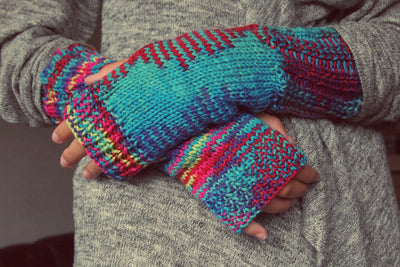
Why Do I Always Feel Cold?
24.07.2023
Always feeling cold?
Brrr! Feeling chilly yet? We’ve had the first few frosty nights of the winter and, despite a relatively mild season so far, the temperature is starting to dip and we’re beginning to layer up to stave off the chills. Some of us, though, feel cold regardless of the weather or time of year. Sound familiar?
If you’ve ever wondered why you’re more sensitive to lower temperatures than your friends and family, and if there’s anything that can be done about it, grab yourself an extra jumper or blanket now and read on:
Men v’s Women:
One reason you’re feeling a bit chilly could be that you’re a woman. As men have much higher levels of higher muscle mass and therefore burn much more energy when resting, they naturally create more heat in the process. As a result, men are less prone to feeling chilly when the temperature is mild or moderate. So ladies, regular exercise to build muscle is a great way to create some internal heat - and make sure you wrap up warm when you can.
Anaemia:
When your body struggles to make enough normal red blood cells to carry oxygen around your body, you are possibly suffering from a form of Anaemia. Again, women are more susceptible to Anaemia but it’s easily treatable and can be managed with good care from your GP. So if you’re feeling extra tired, looking pale, feeling irregular heartbeats and are extra sensitive to feeling cold then it would be advisable to have this checked out by your doctor.
Blood vessel issues:
Some of the issues associated with heart disease can also contribute to you feeling cold. When the arteries supplying blood to your limbs become narrowed, often as a result of a build up of plaque (Arteriosclerosis), they can struggle to generate heat. A good flow of blood is necessary for us to function properly, and the tissue in our limbs relies on this blood to allow movement and heat to flow. When this blood flow is restricted it can make sufferers more prone to feeling cold. If you feel you’re suffering in this way you do need to have yourself checked out by a medical professional.
Another blood vessel issue that could be causing problems is Raynaud’s Disease. This is where the arteries narrow specifically near the finger and toes and you will feel numbness, find it difficult to move your fingers/toes or notice white or blue colouring in the extremities. This is generally nothing to worry about unless you find it is getting worse and affecting your daily life, your symptoms are only on one side or you’re under the age of 12.
Wearing gloves, thick socks and keeping warm with are useful if you suffer from Raynaud’s Disease.
Warming up:
In these colder winter months it’s lovely to reach for a heated blanket, hot water bottle and lots of warm drinks to keep cosy - and if, like many of us are, you’re working from home just now (and trying to avoid having the heating on ALL day) it’s probably a very good idea to layer up, and also to get up and move regularly in order to keep warm.
However, if you feel that you’re still are susceptible to chills than those around you, you should seek medical advice. Often a simple blood test can rule out anything serious and your GP can help you to manage your symptoms depending on the cause of those chills you’re feeling.
Need more support? We're always here to help.
For all your Medical and Homecare supplies give us a call at Mediworld.
We have over 40 years experience in medical, surgical and home health supplies and we're always on hand to chat if you need support or advice. Follow us on Twitter and Facebook.
Learn More Now

Walking for Brain Health
24.10.2023
Walking for Brain Health
It's fair to say that getting out for a good walk is one of the best things we can do for our health and general wellbeing. Walking for just 15 minutes a day can not only add years to your life, it can also act as a kind of 'superpower' by increasing our memory, emotional capacity and cognitive functions. Add to that the fact that spending time outdoors, especially in nature, boosts our happiness, reduces stress and can even get our creative juices flowing, and it's easy to see why we all need to make sure we're taking regular walks for the sake of our general health and wellbeing.
What makes walking so good for our brains?
It's all about the hippocampus - the part of the brain responsible for processing memories, learning, emotions and spacial awareness, amongst other things. This part of our brain evolved to help us move around foraging for food, seeking mates and keeping us away from impending danger. It also helped us to remember all of those skills we'd learned. Today, if we keep that part of our brain exercised, we keep it 'young' and capable of staying on top form. An ageing mind and brain is often associated with the symptoms associated with dementia and memory loss. Maintaining a 'young' and fit brain can really help to ward off those symptoms.
Exercising those brain cells
Walking, for most of us, might seem like a very easy, thoughtless activity. But, in actual fact the demands we put on our cognitive brain while putting one foot in front of the other are far more complex than you might think.
As well as concentrating on keeping our blood flowing, heart pumping and skeleton moving, our brains have to deal with spacial awareness, not bumping into objects, negotiating uneven surfaces, choosing directions and staying alert to potential threats from all around us in order to keep us moving from A to B. Think of it that way and you start to see how complicated a simple walk can be and how maintaining that skill is so important to our cognitive ability.
Boosting creativity
Another impressive side effect, of walking, on the brain is that it can help to spark some impressive levels of creativity. Research has shown that if you're stuck searching for a solution to a problem or are struggling to create/write/draw/perform something you're working on then going for a good walk can help to remove the barriers stopping you from reaching your creative goal. Researchers have found that people are much more able to answer creative-thinking tests while walking than while seated at a desk.
Walk yourself happy
Research shows that regular walking can change the nervous system so dramatically that it can increase your ability to stay positive and experience happier, more motivated emotions. Just a casual stroll for 10-12 minutes can significantly improve mood and focus which in turn improves our working memory and increases our recall and retaining capacity. Thus leading to a greater chance of staving off the effects of dementia in later years.
So it's difficult to argue against the benefits of a good walk. If you're heading out for a walk today, remember the positive effect it's having on your brain and body and the investment you're making in your body and brain for a better, more healthy life.
For those who need a little extra support when walking, we can help to kit you out with the right walking aids for your individual needs.
For all your Medical and Homecare supplies give us a call at Mediworld.
We have over 40 years experience in medical, surgical and home health supplies and we're always on hand to chat if you need support or advice. Follow us on Twitter and Facebook.
Learn More Now
